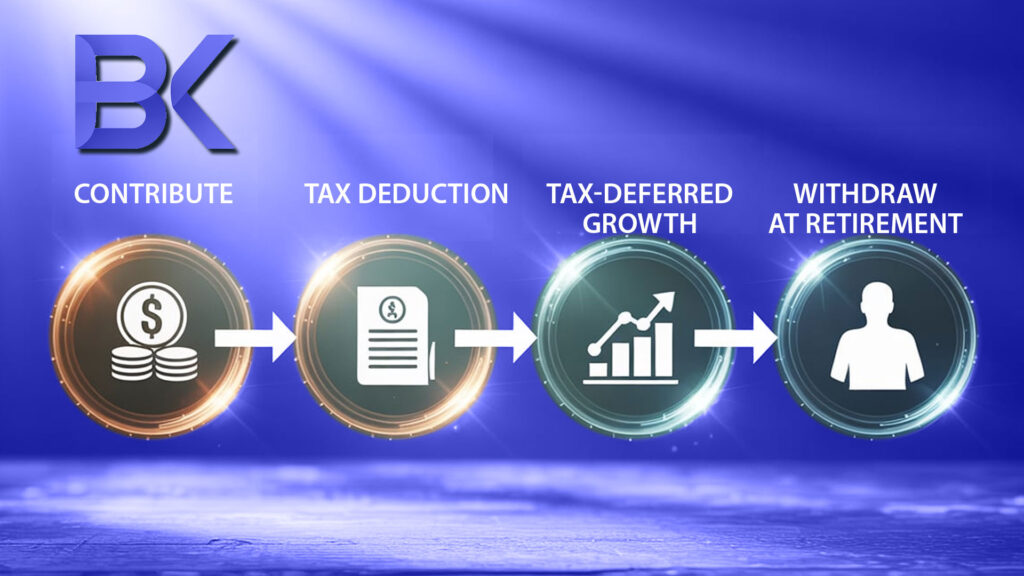The Registered Retirement Savings Plan (RRSP) has long been recognized as one of Canada’s most effective tools for building long-term wealth and securing financial stability after retirement. What makes it especially valuable is its unique combination of immediate tax relief and tax-deferred growth. For residents of Quebec, this advantage is even more pronounced: both federal and provincial income taxes place a heavier burden on earnings compared to most other provinces. Every dollar contributed to an RRSP therefore reduces not just federal tax but also provincial tax, creating a powerful two-level shield that helps Canadians keep more of what they earn today while preparing for tomorrow.
Planning around RRSPs is not simply about saving money. It is about using the account strategically, making contributions in years with higher income, coordinating with other registered accounts such as the FHSA or TFSA, and planning withdrawals in a way that minimizes lifetime tax exposure. Done correctly, an RRSP becomes more than a savings account: it is a cornerstone of long-term financial planning.
This 2025 guide brings together the latest contribution rules, explains the unique withholding structure that applies in Quebec, and highlights common pitfalls that too often cost residents thousands of dollars in unnecessary taxes.
Contribution Limits and Rules (2025)
- Annual maximum contribution limit (2025): CAD 32,490.
This figure is adjusted each year based on inflation. It ensures that RRSP room grows in line with rising income levels and cost of living. - Percentage of income rule. Your personal limit is the lower of 18% of your earned income from the previous year or the annual cap. For example, someone with an income of CAD 100,000 in 2024 would have CAD 18,000 of new RRSP room in 2025, provided this does not exceed the CAD 32,490 cap.
- Carry-forward of unused room. If you have not fully used your RRSP contribution room in past years, the unused portion automatically carries forward indefinitely. This allows individuals to “catch up” later, particularly useful for professionals whose income rises sharply in mid-career.
- Pension adjustment (PA). Members of a workplace pension plan (RPP) receive less RRSP room, as contributions to employer-sponsored pensions are counted toward retirement savings. This ensures fairness but requires employees to pay close attention to their annual Notice of Assessment from the Canada Revenue Agency (CRA).
- Deadline for 2024 contributions. Contributions made up to March 1, 2025 can be claimed on your 2024 tax return. This 60-day grace period gives taxpayers the flexibility to calculate income for the year and then make contributions to reduce their tax bill.
- Maximum contribution age. You may contribute to your RRSP until December 31 of the year in which you turn 71. After that, the account must be converted into a Registered Retirement Income Fund (RRIF) or used to purchase an annuity. Both options begin the process of drawing down savings in a structured, taxable way.
Tax Advantages of RRSPs
The RRSP is a dual-benefit instrument:
- Immediate tax deduction. Contributions reduce your taxable income in the year they are claimed.
- Tax-deferred growth. Investment income inside the RRSP — dividends, capital gains, interest grows without being taxed until withdrawal.
- Income smoothing. Withdrawals are taxed as regular income, ideally when you are retired and in a lower marginal tax bracket.
For high-income Canadian residents, these deductions can mean thousands of dollars back each year, which can be reinvested or used to accelerate debt repayment.
Withholding Taxes in Quebec
When funds are withdrawn, financial institutions must withhold income tax at source. Quebec has a distinctive structure compared to other provinces:
Federal withholding (Quebec residents):
- Up to $5,000 — 5%
- $5,001 to $15,000 — 10%
- Over $15,000 — 15%
Quebec provincial withholding:
- A flat 14% provincial tax applies to lump-sum withdrawals.
This means a withdrawal of $10,000 could face 24% withheld upfront ($1,000 federal + $1,400 provincial). The final amount owed or refunded is reconciled when filing your tax return.
Importantly, transfers between registered accounts (e.g., RRSP → RRIF, RRSP → another RRSP) are not subject to withholding.
Special Programs: HBP and LLP
RRSPs are not always locked away until retirement. Two programs allow temporary withdrawals without penalty if conditions are met:
- Home Buyers’ Plan (HBP). Withdraw up to $60,000 for the purchase of a first home. The amount must be repaid into the RRSP over 15 years after a grace period of 5 years.
- Lifelong Learning Plan (LLP). Withdraw up to $20,000 ($10,000 per year) to fund full-time education or training. Repayment is required over 10 years.
Both programs are widely used in Quebec, particularly by younger professionals balancing career growth and the dream of home ownership.
Common Mistakes to Avoid
- Over-contributing. Exceeding your RRSP room by more than the $2,000 lifetime grace limit triggers a penalty tax of 1% per month on the excess.
- Forgetting about withholding. Many assume withdrawals are “tax-free” once deducted, but both federal and provincial taxes apply at source.
- Ignoring the pension adjustment. Employer plans reduce your RRSP room; not accounting for this may lead to accidental over-contributions.
- Frequent withdrawals. Each withdrawal permanently erodes your tax-deferred growth potential.
- Lack of coordination with TFSA or FHSA. Using the wrong mix of accounts can reduce overall efficiency and tax savings.

A Practical RRSP Strategy for Canadian Residents
- Maximize contributions in high-income years. The higher your marginal tax rate, the more valuable each dollar contributed.
- Reinvest your tax refund. Use refunds to top up contributions or pay down high-interest debt.
- Leverage HBP or LLP wisely. These programs can help with major life goals but must be repaid on schedule.
- Plan withdrawals carefully. Avoid large lump sums where possible; stagger withdrawals to reduce withholding and final tax liability.
- Think long term. Once you approach age 71, decide whether a RRIF, annuity, or gradual withdrawals align best with your retirement plan.
RRSP Contribution and Withdrawal Rules at a Glance (2025)
| Category | Details |
| Annual Contribution Limit (2025) | CAD 32,490 or 18% of previous year’s earned income (whichever is lower) |
| Carry-Forward Room | Unlimited, accumulates year to year |
| Deadline for 2025 Contributions | March 1, 2026 |
| Maximum Age for Contributions | December 31 of the year you turn 71 |
| Pension Adjustment (PA) | Reduces RRSP room if enrolled in a workplace pension plan |
| Withholding (Federal, Quebec Residents) | 5% up to $5,000; 10% $5,001–$15,000; 15% above $15,000 |
| Provincial Withholding (Quebec) | Additional 14% on lump-sum withdrawals |
| Special Programs | HBP: up to $60,000 for a first home; LLP: up to $20,000 for education |
| Over-Contribution Penalty | 1% per month on amounts exceeding $2,000 grace room |
FAQ: RRSP in Quebec (2025)
1. What is an RRSP?
The Registered Retirement Savings Plan (RRSP) is a registered account that allows Canadians to reduce taxable income today and grow investments tax-deferred until withdrawal.
2. How much can I contribute in 2025?
Your limit is the lower of 18% of your earned income from the previous year or CAD 32,490 (the 2025 cap). Unused room carries forward indefinitely.
3. Can Quebec residents deduct RRSP contributions from both federal and provincial taxes?
Yes. Contributions reduce taxable income at both levels, which is especially valuable given Quebec’s high combined tax rates.
4. What happens if I overcontribute?
You may exceed your limit by up to CAD 2,000 without penalty. Any excess beyond that is subject to a 1% per month penalty until withdrawn.
5. How does RRSP withholding tax work in Quebec?
Withdrawals face federal withholding (5–15%) plus a flat 14% provincial withholding. For example, a $10,000 withdrawal has 24% withheld upfront. Final liability is reconciled at tax filing.
6. Are transfers between registered plans taxed?
No. Transfers such as RRSP → RRSP, RRSP → RRIF, or RRSP → annuity are tax-deferred and not subject to withholding.
7. What are the HBP and LLP programs?
- Home Buyers’ Plan (HBP): withdraw up to $6035,000 for a first home; must repay over 15 years.
- Lifelong Learning Plan (LLP): withdraw up to $20,000 for education; repayment required over 10 years.
8. Until what age can I contribute to my RRSP?
You may contribute until December 31 of the year you turn 71. After that, the account must be converted to a RRIF or annuity.
9. Should I prioritize RRSP or TFSA?
High-income earners in Quebec often benefit more from RRSP deductions upfront, while TFSAs provide flexibility and tax-free withdrawals. Many residents use both strategically.
10. Can both spouses contribute to RRSPs?
Yes. In addition, a spousal RRSP allows higher-income partners to contribute to the other’s RRSP, helping split retirement income and reduce future tax liability.
Why Work With Boris Kolodner Financial Services
At Boris Kolodner Financial Services, we know that retirement planning in Quebec is not one-size-fits-all. With layered federal and provincial tax rules, RRSP strategies here require more than just filling contribution room; they demand precision.
Here’s how we help you get it right:
- Maximize every dollar. We ensure you use your annual RRSP room strategically, avoiding costly over-contribution penalties.
- Coordinate all accounts. Your RRSP plan is integrated with FHSA, TFSA, RDSP, RESP, Non-registered and employer pensions to create one efficient wealth strategy.
- Minimize lifetime tax. From contribution timing to RRSP-to-RRIF conversion, we design withdrawal strategies that keep more money in your pocket.
- Stay fully compliant. Our team makes sure every step aligns with CRA and Revenu Québec regulations.
Financial independence in Quebec isn’t just about saving, it’s about saving smarter, with a clear plan tailored to your income, lifestyle, and long-term goals.
Take the Next Step
📞 Call: 514-834-5558
📧 Email: contact@bkfinancialservices.ca
💻 Book a free consultation: Discover how a personalized RRSP strategy can reduce your tax bill today and secure your retirement tomorrow.


